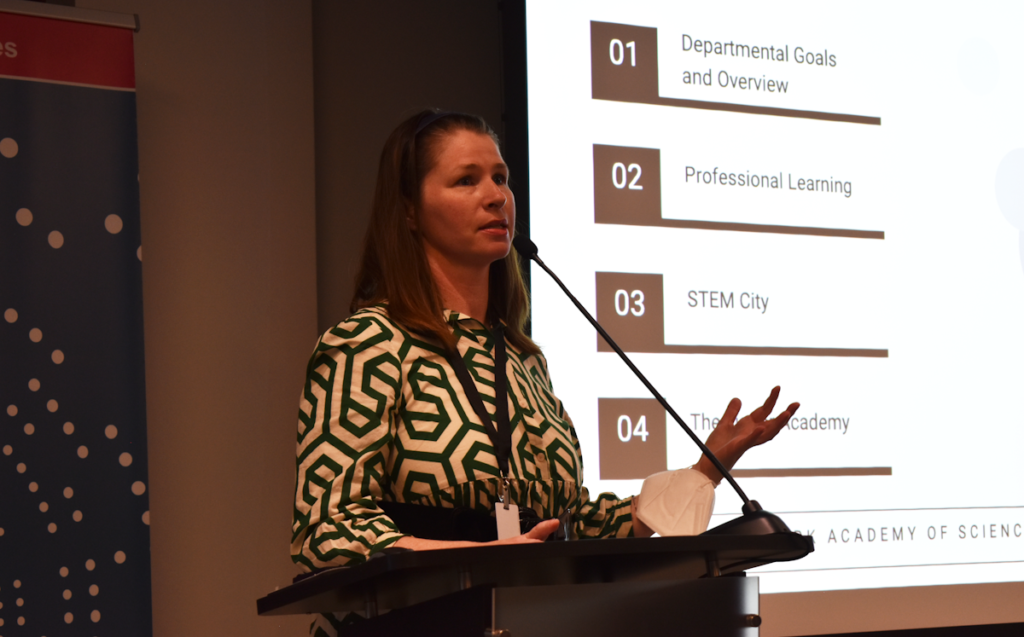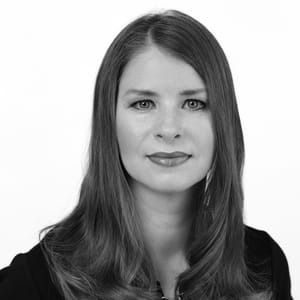The Junior Academy Induction Ceremony

Published November 14, 2023
By Meghan Groome, PhD
Senior Vice President of Education
At its 205th Annual Member Meeting on November 14, 2023, The New York Academy of Sciences launched a new tradition: the induction of our Junior Academy members into our membership ranks.
The Junior Academy has been engaging students since its founding in 1948 when the Academy began hosting the City-wide science and engineering fair. The arrival of this research competition dramatically increased the need for mentored research experiences in labs around the City. Recognizing the opportunity gap, the Academy began hosting regular meetups. These conversations led to a match making program that eventually found a new home online with the creation of Launchpad in 2016. Through Launchpad, a matchmaking and collaboration platform designed to help students find research partners and mentors, Junior Academy programming became more accessible than ever before. Today, any student with a device and access to the internet can participate in a world-class mentored research program.
At the Junior Academy, we work with partners to build a community of students and mentors who work in teams to solve open innovation challenges. The challenges are real world problems scoped out by our sponsors and brought to life by our education team. Since moving online, we’ve served over 10,000 students from over 100 countries by administering over 50 open innovation challenges.
Working in a group presents a unique set of challenges, especially in STEM research – which is itself no easy task. However, we know that diverse teams produce better research and innovation. We believe – and the proof is in our evaluations – that great teamwork can be taught and mentored. Collaboration, communication, and creativity are essential components of teamwork and skills that will translate to overcoming obstacles in any setting. We at the Academy are proud to provide a space for students and mentors to come together to participate in engaging STEM programming that believes in science for the greater good.
The Junior Academy wouldn’t be possible without the mentorship that our members provide. Research has proved, time and time again, that mentors are often the difference between loving STEM and persisting in STEM. Their energy and enthusiasm have allowed us to make a generational impact both abroad and in New York. Our members have donated over 4.5 million hours of their time to mentor the next generation.
At our 205th Annual meeting, we inducted 2,834 students from around the world into the Academy. These students completed our rigorous semester-long research experience during the 2022-2023 School Year.
Last year, over 700 teams of students:
- Designed ways to use 5G and the Internet of Things to improve energy efficiency;
- Explored the extremes of space, underwater and the edges of scientific discovery;
- Documented the impacts of climate change on public health;
- Discovered the connection between forest management and a sustainable future;
- Designed urban micro gardens to address malnutrition and hunger in their neighborhoods;
- Led the way in understanding the connections between human rights and cybersecurity;
- Uncovered decades of water mismanagement to design and retrofit new, safe drinking water systems;
- Rose to the challenge of building green schools, homes and other community structures; and finally,
- Made healthier snacks that balance taste and nutrition.
At the Academy, we like to say that we shape the future of science. And that’s very true, but it’s important to point out that our youngest members aren’t just the future. They’re doing incredible things right now.
Transcript
Thank you for welcoming us to the Annual Meeting. My name is Dr. Meghan Groome and I’m the Senior Vice President for Education at the Academy. I’m here to represent all of the people at the Academy who make our education programs so powerful including the program team of Kaitlin Green, Rosemary Puckett and Sabrina Debler. I’d also like to thank the entire education team, AV/ IT, communications, membership and marketing teams.
This is truly a cross organizational effort and I want to thank everyone from the executive office to HR for all their hard work to bring this program to life. I’d especially like to thank our Advancement team who raised the funds to allow this program to be completely free to our students. And with that, I’d like to thank our generous sponsors who support our work with not only their funding but also their guidance, insight, and expertise.
They include:
- The Royal Academy of Engineering in Sweden
- The J. Christopher Stevens Virtual Exchange Initiative i.e. Stevens Initiative sponsored by the US Department of State, with funding provided by the U.S. Government, and is administered by the Aspen Institute and supported by the Bezos Family Foundation and the governments of Morocco and the United Arab Emirates
- Clifford Chance’s Cornerstone Initiative
- Ericsson
- The Ministry of Higher Education of Oman, and
- NEOM
- Foundation for the National Institutes of Health
- S & P Global
I’d also like to thank our incredible on the ground partners including the Royal Health Awareness Society in Jordan, Mentor Arabia and AMU.
I’d also like to thank all the parents, teachers, siblings, friends and alumni who cheer on our students, encourage them to apply and help explain to worried parents that no, they really are up at 3am watching a live stream about the flexible use of electricity.
Lastly, we also would like to take a moment to thank our international cohort of Mentors who worked with student teams and guided them through The Junior Academy learning process. Our members are the engine of our programs, serving as mentors, judges and now, a generation of alumni. Their energy and enthusiasm have allowed us to make a generational impact both abroad and especially in New York. We are so grateful for your time and expertise.
It’s clear from the research that mentors are often the difference between loving STEM and persisting in STEM. If you have a moment, I’d like you to think about your own mentor. How they shaped you. How they gave you a critical boost. I’d personally like to thank my mentor, Ruth Cohen, and I encourage all of us to thank our mentors and pass their wisdom forward to the next generation.
With all of my thanks out of the way, I’d like to talk about the Junior Academy itself. Founded in 1948, the Academy began hosting the City-wide science and engineering fair. The arrival of this research competition dramatically increased the need for mentored research experiences in labs around the City. Recognizing the opportunity gap, the Academy began hosting regular meetups. These conversations led to a match making program that eventually found a new home online in 2016.
With the advent of a new online platform, mentored research experiences could be moved online and scaled to any student with a device and access to an internet connection. In today’s Junior Academy, we work with partners to build a community of students and mentors who work in teams to solve open innovation challenges. The challenges are real world problems scoped out by our sponsors and brought to life by our education team. Since we moved online, we’ve served over 10,000 students from over 100 countries by administering over 50 open innovation challenges.
Last year, nearly 700 teams:
- Designed ways to use 5G and the Internet of Things to improve energy efficiency,
- Explored the Extremes of Space, underwater and the edges of scientific discovery,
- Documented the impacts of climate change on public health,
- Discovered the connection between forest management and a sustainable future,
- Designed urban micro gardens to address malnutrition and hunger in their neighborhoods,
- led the way in understanding the connections between human rights and cybersecurity,
- Uncovered decades of water mismanagement to design and retrofit new, safe drinking water systems
- Rose to the challenge of building green schools, homes and other community structures, and finally, my favorite,
- Made healthier snacks that balance taste and nutrition.
In addition to the Junior Academy, nearly 800 students participated in the 1000 Girls, 1000 Futures program. Students worked in close-knit teams with mentors to build core scientific and work ready skills that complement their research projects.
On its own, STEM research is hard. In a team, STEM reach can be even harder. But we know that diverse teams produce better research and innovation. We believe, and the proof is in our evaluations, that great teamwork can be taught and mentored. Collaboration, communication, and creativity are essential components of team work, and for that matter, overcoming obstacles in any setting. We at the Academy are proud to provide a space for students and mentors to come together to participate in engaging STEM programming that believes in science for the greater good.
Bringing together young people from around the globe in a STEM-enriched environment can open doors and prepare students for science paths otherwise unknown and we are so pleased to be a part of their STEM journey.
Today, we inducted 2,834 students from the Junior Academy and 1000 Girls 1000 Futures to join the New York Academy of Sciences as Young Members. We are so proud of you and pleased to connect you with the legacy of the Academy. At the Academy, we like to say that we shape the future of science. And that’s very true, but I always like to point out that our youngest members aren’t just the future, they’re doing incredible things right now.
Please join me in welcoming the Junior Academy Class of 2023 into the New York Academy of Sciences.
